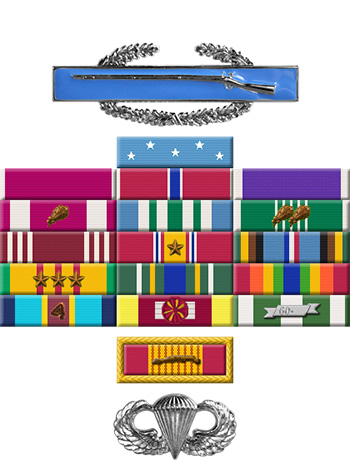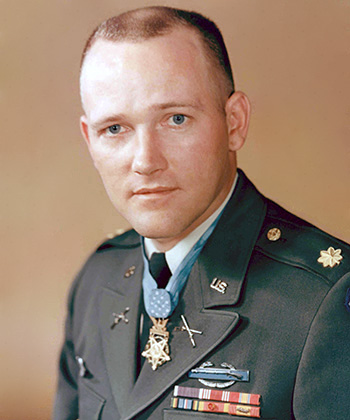
|
Roger H.C. Donlon |
 |
|||
| Rank, Service | ||||
Colonel O-6, U.S. Army |
||||
| Veteran of: | ||||
|
||||
| Tribute: | ||||
Roger Donlon was born on January 30, 1934, in Saugerties, New York. He enlisted in the U.S. Air Force on December 16, 1953, and completed basic training at Sampson AFB, New York, in January 1954. Airman Donlon served at Stewart AFB, New York, where he attended the U.S. Military Academy Prep School before receiving an honorable discharge to attend West Point on July 4, 1955. He entered the U.S. Military Academy on July 5, 1955, but left before graduating. Donlon enlisted in the U.S. Army on February 5, 1958, and was commissioned a 2d Lt in the U.S. Army through the Infantry Officer Candidate School at Fort Benning, Georgia, on June 24, 1959. Lt Donlon next attended Airborne School, followed by service as a training officer, executive officer, and company commander with the 5th Training Regiment at Fort Jackson, South Carolina, from August 1959 to July 1961. He served as a platoon leader with Company E, 1st Brigade of the 9th Infantry Regiment in Alaska from July 1961 to March 1962, and then as Aide-de-Camp to the commander of Yukon Command in Alaska from March 1962 to August 1963. Capt Donlon next served as an adjutant with Detachment C-1, Company A, 7th Special Forces Group at Fort Bragg, North Carolina, from August 1963 to January 1964, followed by service as Commanding Officer of Detachment A-26, Company C, 7th Special Forces Group at Fort Bragg from January to November 1964. During time he deployed with his unit to South Vietnam from May to November 1964. He served with Headquarters 7th Special Forces Group at Fort Bragg from November 1964 to August 1965, and then attended the Infantry Officer Career Course at Fort Benning from August 1965 to May 1966. Maj Donlon received an assignment to complete his bachelor's degree at the University of Omaha, Nebraska, from May 1966 to March 1967, followed by service as Commandant of the Advanced Combat Training Academy with 2nd Battalion, 9th Infantry Regiment of the 2nd Infantry Division in South Korea from May 1967 to June 1968. He served as Assistant G-3 Training Officer with the 5th Infantry Division at Fort Carson, Colorado, from August 1968 to July 1970, and then attended Command and General Staff College at Fort Leavenworth, Kansas, from August 1970 to June 1971. Maj Donlon attended training at the Foreign Service Institute in Washington, D.C., from July to November 1971, and then served as a training advisor with U.S. Military Assistance Command Vietnam from January to August 1972, and with U.S. Military Assistance Command Thailand from September 1972 to May 1974. LTC Donlon's next assignment was as a Service Test Project Officer with the U.S. Army Infantry Board at Fort Benning from June 1974 to January 1976, followed by service with the School Brigade at Fort Benning from January to December 1976. He served as Battalion Commander of 3rd Special Forces Battalion, 7th Special Forces Group in the Panama Canal Zone from January 1977 to August 1978, and then as an Instructor and as Director of Allied Personnel at U.S. Army Command and General Staff College at Fort Leavenworth from August 1978 to July 1981. Col Donlon attended the Defense Language Institute Foreign Language School at the Presidio of Monterey, California, from September 1981 to May 1982, followed by the Foreign Area Officer Course at Fort Bragg from July to December 1982. He received an assignment to complete his graduate studies at Campbell University from December 1982 to July 1983, and then attended additional training at the John F. Kennedy Special Warfare School at Fort Bragg from July to November 1983. Col Donlon served as Commander of the U.S. Army Element to the United Nations Command in Japan from November 1983 to August 1987, and then as Alternate President to the Physical Evaluation Board at the the Presidio of San Francisco from August 1987 until his retirement from the Army on December 17, 1988. Col Donlon was the first recipient of the Medal of Honor for action during the Vietnam War, and he was also the first Special Forces soldier in history to be awarded the Medal of Honor. |
||||
|
||||

